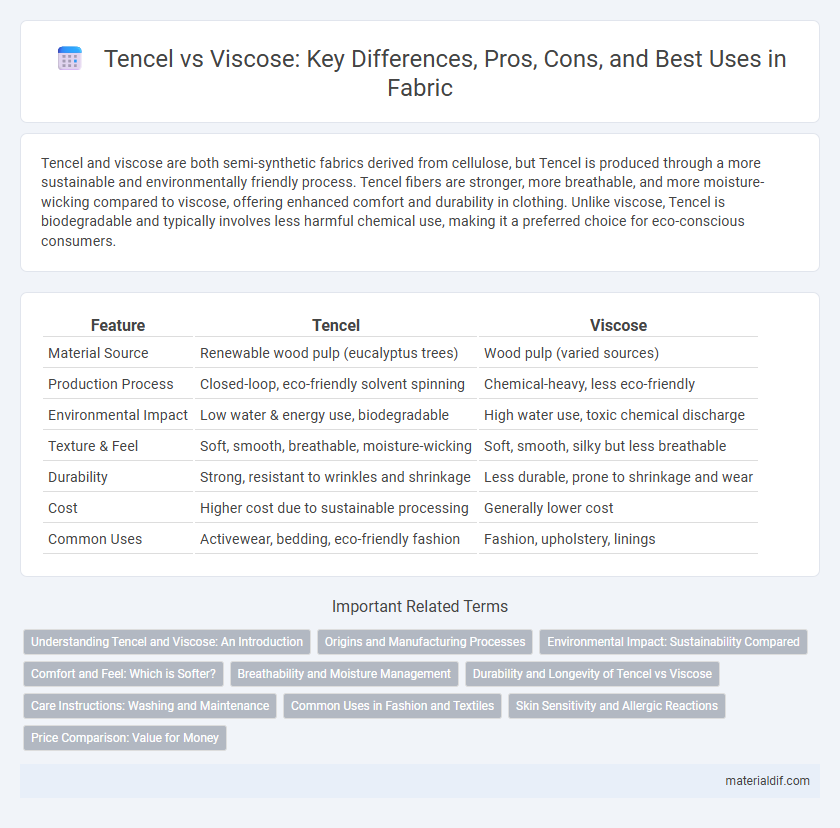Tencel and viscose are both semi-synthetic fabrics derived from cellulose, but Tencel is produced through a more sustainable and environmentally friendly process. Tencel fibers are stronger, more breathable, and more moisture-wicking compared to viscose, offering enhanced comfort and durability in clothing. Unlike viscose, Tencel is biodegradable and typically involves less harmful chemical use, making it a preferred choice for eco-conscious consumers.
Table of Comparison
| Feature | Tencel | Viscose |
|---|---|---|
| Material Source | Renewable wood pulp (eucalyptus trees) | Wood pulp (varied sources) |
| Production Process | Closed-loop, eco-friendly solvent spinning | Chemical-heavy, less eco-friendly |
| Environmental Impact | Low water & energy use, biodegradable | High water use, toxic chemical discharge |
| Texture & Feel | Soft, smooth, breathable, moisture-wicking | Soft, smooth, silky but less breathable |
| Durability | Strong, resistant to wrinkles and shrinkage | Less durable, prone to shrinkage and wear |
| Cost | Higher cost due to sustainable processing | Generally lower cost |
| Common Uses | Activewear, bedding, eco-friendly fashion | Fashion, upholstery, linings |
Understanding Tencel and Viscose: An Introduction
Tencel is a sustainable fabric made from sustainably sourced wood pulp, primarily eucalyptus trees, using a closed-loop production process that recycles water and solvents, minimizing environmental impact. Viscose, also known as rayon, is derived from cellulose fibers typically sourced from wood pulp but involves more chemically intensive manufacturing steps, often resulting in higher environmental concerns. Both fabrics offer soft, breathable textures ideal for clothing, but Tencel stands out for its eco-friendly production and superior moisture-wicking properties.
Origins and Manufacturing Processes
Tencel is a branded form of lyocell fiber derived from sustainably sourced wood pulp, primarily eucalyptus, using a closed-loop manufacturing process that recycles water and solvents to minimize environmental impact. Viscose, also known as rayon, originates from cellulose extracted from wood pulp, but its production involves chemical-intensive processes like carbon disulfide treatment, which are less eco-friendly and generate more waste. The key distinction in manufacturing is Tencel's eco-conscious solvent-spinning technique compared to viscose's traditional, pollutive chemical methods.
Environmental Impact: Sustainability Compared
Tencel, made from sustainably harvested eucalyptus trees through a closed-loop process, has a significantly lower environmental impact compared to viscose, which relies heavily on chemical-intensive production and often involves deforestation. The closed-loop system in Tencel manufacturing recycles water and solvents, reducing pollution and energy consumption, while viscose production typically releases harmful chemicals into waterways. Tencel's biodegradability and renewable sourcing make it a more sustainable choice in fabric production than traditional viscose.
Comfort and Feel: Which is Softer?
Tencel fibers offer superior softness due to their smooth surface and moisture-wicking properties, making the fabric feel cool and gentle against the skin. Viscose, while also soft and silky, tends to be less breathable and can feel heavier or clingy in comparison. The natural structure of Tencel enhances comfort by reducing irritation, making it the preferred choice for softness and a luxurious feel.
Breathability and Moisture Management
Tencel fabric exhibits superior breathability compared to viscose, allowing better air circulation that keeps the wearer cooler and more comfortable. Its moisture management properties efficiently wick moisture away from the skin, promoting faster evaporation and maintaining dryness. Viscose, while soft and smooth, tends to retain moisture longer and offers less effective ventilation, making Tencel the preferred choice for active and humid conditions.
Durability and Longevity of Tencel vs Viscose
Tencel, made from sustainably sourced wood pulp, offers superior durability and longevity compared to viscose due to its stronger fiber structure and resistance to wear and tear. Viscose tends to be weaker and more prone to pilling, shrinking, and stretching over time, resulting in a shorter lifespan. The moisture-wicking abilities and enhanced tensile strength of Tencel contribute to garments that maintain their shape and appearance longer than viscose alternatives.
Care Instructions: Washing and Maintenance
Tencel fabric requires gentle washing in cold water with mild detergent, maintaining its softness and durability while avoiding bleach and fabric softeners. Viscose demands even more delicate care by hand washing or using a gentle machine cycle with cold water, as it tends to shrink and lose shape when exposed to heat or agitation. Air drying is recommended for both fabrics to prevent damage, with Tencel benefiting from drying flat and Viscose from hanging to maintain fiber integrity.
Common Uses in Fashion and Textiles
Tencel is commonly used in sustainable fashion collections for its moisture-wicking properties and soft texture, ideal for activewear, casual clothing, and eco-friendly textiles. Viscose finds widespread application in everyday apparel such as dresses, blouses, linings, and home textiles due to its silk-like appearance and drape. Both fabrics are popular choices in the fashion industry, with Tencel favored for durability and sustainability, while Viscose is chosen for affordability and versatility.
Skin Sensitivity and Allergic Reactions
Tencel, derived from sustainably sourced eucalyptus fibers, is known for its hypoallergenic properties and superior breathability, making it ideal for sensitive skin. Viscose, while also soft, undergoes chemical processing that can sometimes leave residues triggering allergic reactions or irritation. Consumers with skin sensitivities often prefer Tencel due to its natural moisture-wicking ability and reduced risk of causing dermatitis.
Price Comparison: Value for Money
Tencel fabric typically commands a higher price than viscose due to its sustainable production process and superior durability, offering long-term value for eco-conscious consumers. Viscose is more affordable upfront but tends to wear out faster and may require more frequent replacement, impacting overall cost-effectiveness. Investing in Tencel provides a balance of comfort, environmental benefits, and durability, making it a smarter choice for value-conscious buyers over time.
Tencel vs Viscose Infographic

 materialdif.com
materialdif.com